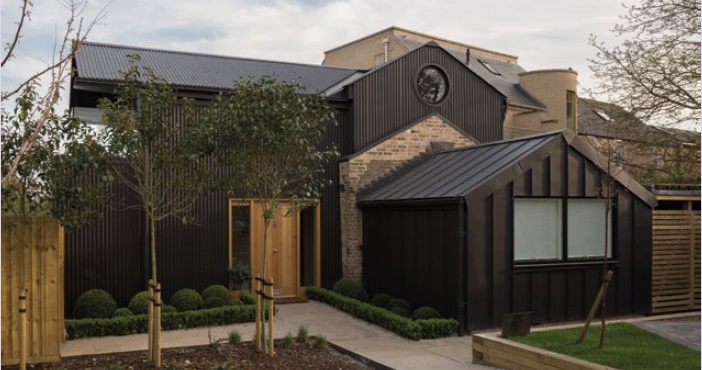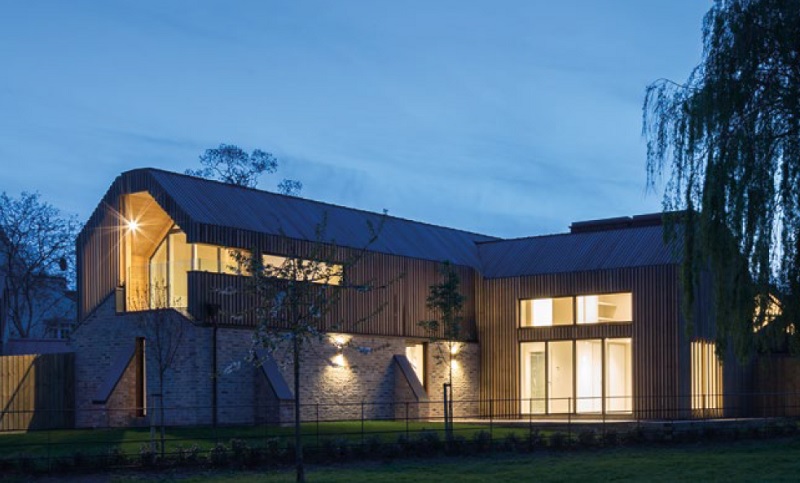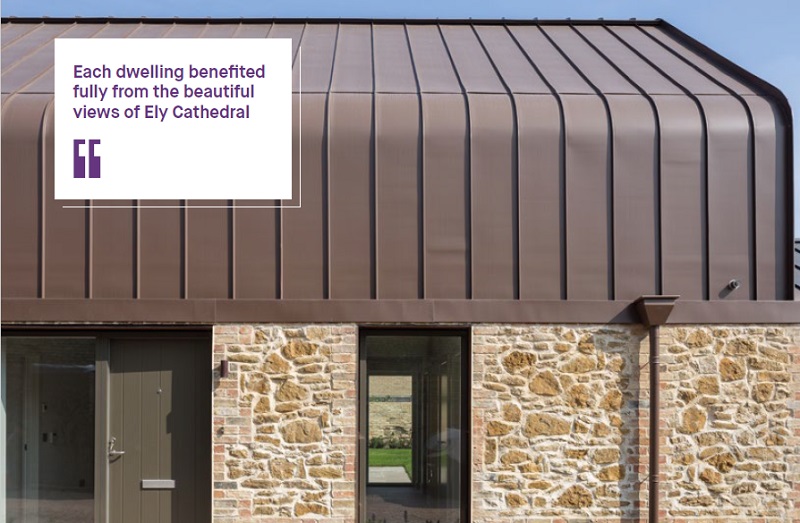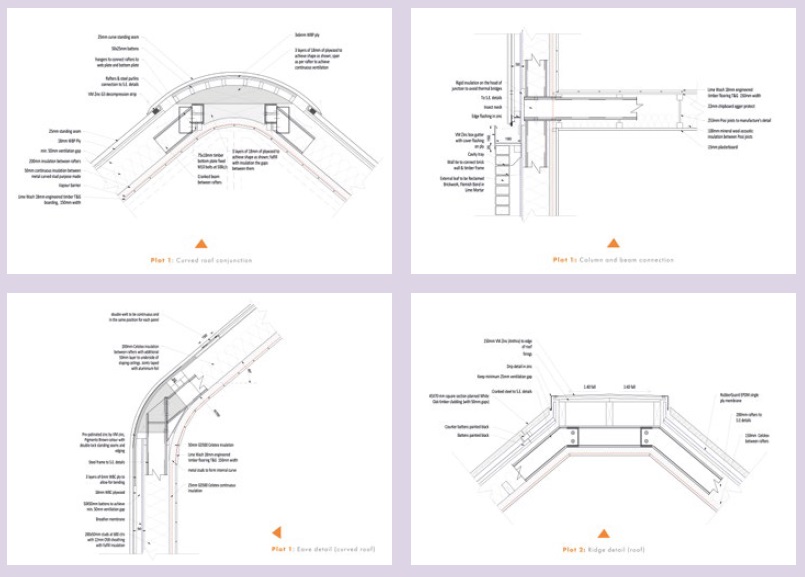Waterside barns: a radical design approach

|
| Cambridge-based PiP Architecture, a CIAT Registered Practice, has completed the radical transformation of three neglected agricultural barns into three energy-efficient family homes fronting the riverside in the centre of Ely, Cambridgeshire. |
Contents |
[edit] Introduction
Situated on the waterfront, just five minutes’ walk from Ely train station, the barns were once used for housing livestock when they were part of Lavender Farm, dating back to the late 1800s. The first challenge was to retain the historic fabric and character of the barns while making them suitable for modern family life. PiP’s radical solution was to remove the roof of each barn and ‘drop’ a new building inside the original. This allowed the new buildings to be two storeys high, thereby taking advantage of the stunning riverside views and maximising the living space available for a comfortable family home.

|
[edit] Design and construction
As the retained 19th century barns were on shallow foundations, PiP proposed localised pad foundations and underpinning to minimise movement and disruption to the historic fabric. The design incorporated steel frames to bear the weight of the new buildings and direct load through to the ground. The structure was infilled with a stick-built timber frame that allowed quick and easy erection of the main structure – an approach that also achieved a weathertight state faster than a traditional method of construction. This methodology also ameliorated the very tight access arrangements that prevented the use of traditional methods such as bricks and mortar or more sustainable methods such as SIP panels, which would have required the use of either lorries or a crane. To further minimise unnecessary complexity during the build, a coherent frame construction was applied to all three units.
To satisfy the requirements of the local planning authority, PiP’s design presented three unique dwellings that together created a development of overall coherence. This was achieved by selecting external cladding finishes to provide variation in appearance while using a carefully-considered palette of contrasting yet sympathetic materials across all the buildings.

|
Given the prestigious central location of the barns, the PiP team ensured that each dwelling benefited fully from the beautiful views of Ely Cathedral, Lavender Green and the River Cam by inverting the accommodation design. All living areas are located on the first floor within vaulted ceilings and enjoy south facing, solar-shaded roof terraces. Bedroom accommodation is located on the ground floor facing south with ancillary rooms and studies on the northern aspects.
With floorspace within the dwellings restricted by the footprint of the original barns, PiP minimised unnecessary circulation space to optimise living area amenity. All internal walls are non-loadbearing, allowing adaptation to the different lifestyles and needs of future residents, while the wide and open lobby design allows easy installation of platform lifts ensuring these will be lifetime homes for their occupants. Similarly, fluent disabled access throughout the ground floors and flexible disabled provision on the upper floors safeguards the diverse accessibility needs of future occupants.
Each building at Waterside showcases a contrasting material, chosen to complement the others in their rich and natural palettes. The materials chosen for each plot relate directly to its context. Plot 1 takes its cue from the colour tones of the stone walling of the barn it is constructed within; Plot 2 is surrounded by trees and clad in timber; while Plot 3, which fronts the river, features a boathouse influenced design. All materials used are low maintenance and sustainable to ensure longevity and minimum environmental impact. Innovative design and construction techniques safeguard against vulnerabilities: for example, the gaps between the white American oak cladding are protected against UV deterioration by the application of RubberGard.
Throughout the development, simple innovative detailing delivers high-quality finish to the design. In close collaboration with VM Zinc, the development pioneered the use of sine-wave profile rainscreen wall cladding on one of the roofs. This PiP ground-breaking innovation is now being imitated widely in designs across the country. The curved zinc eaves and ridge details, crucially manufactured in single lengths, were sourced through a fabrication company in the north of England.
PiP believes it has a responsibility to design and build low-energy buildings. It is committed to creating spaces with a focus on delivering occupant comfort by minimal means, founded upon sustainable design from the onset, through subtle, innovative solutions integrated into the architecture itself. These principals are intrinsic to Waterside.
All units within the Waterside development achieve an SAP energy efficiency rating of ‘A’. The design uses window positions and building canopies to maximise solar gain during the winter months and provide effective solar shading during the summer. The external materials are all low maintenance and boast a proven longevity. While the simplified frame construction minimised build costs, it did so without compromising the superior finish of this showcase development.
PiP’s radical development at Waterside, Ely secured the confidence of the local authority, which gave its full support under delegated powers. With this development, PiP has succeeded in forming a striking contemporary design that enhances the public experience of the riverside enjoyed by the many visitors to Ely; it also respects the traditional proportions and materials of these beautiful historic barns and preserves the sensitivity of the local conservation area and listed buildings.
[edit] Project data
- Start on site: April 2018
- Completion: May 2019
- Designers: PiP Architecture
- Structural engineer: Gawn Associates
- Approved building inspector: East Cambridgeshire District Council
- Main contractor: Dean and Dean Construction
[edit] About this article
This article was written by Chris Senior MCIAT, PiP Architecture. It was first published in CIAT’s AT Journal, Issue 130, Summer 2019 and can be accessed HERE.
Other articles by CIAT on Designing Buildings Wiki are found HERE.
[edit] Related articles on Designing Buildings Wiki
- Article 4 direction.
- Change of use class.
- Local development order.
- National planning policy framework.
- Permitted development.
- Planning enforcement.
- Planning permission.
- Prior approval.
- Town and Country Planning (General Permitted Development) (Amendment) (England) Order.
- Use class.
--CIAT
Featured articles and news
RTPI leader to become new CIOB Chief Executive Officer
Dr Victoria Hills MRTPI, FICE to take over after Caroline Gumble’s departure.
Social and affordable housing, a long term plan for delivery
The “Delivering a Decade of Renewal for Social and Affordable Housing” strategy sets out future path.
A change to adoptive architecture
Effects of global weather warming on architectural detailing, material choice and human interaction.
The proposed publicly owned and backed subsidiary of Homes England, to facilitate new homes.
How big is the problem and what can we do to mitigate the effects?
Overheating guidance and tools for building designers
A number of cool guides to help with the heat.
The UK's Modern Industrial Strategy: A 10 year plan
Previous consultation criticism, current key elements and general support with some persisting reservations.
Building Safety Regulator reforms
New roles, new staff and a new fast track service pave the way for a single construction regulator.
Architectural Technologist CPDs and Communications
CIAT CPD… and how you can do it!
Cooling centres and cool spaces
Managing extreme heat in cities by directing the public to places for heat stress relief and water sources.
Winter gardens: A brief history and warm variations
Extending the season with glass in different forms and terms.
Restoring Great Yarmouth's Winter Gardens
Transforming one of the least sustainable constructions imaginable.
Construction Skills Mission Board launch sector drive
Newly formed government and industry collaboration set strategy for recruiting an additional 100,000 construction workers a year.
New Architects Code comes into effect in September 2025
ARB Architects Code of Conduct and Practice available with ongoing consultation regarding guidance.
Welsh Skills Body (Medr) launches ambitious plan
The new skills body brings together funding and regulation of tertiary education and research for the devolved nation.
Paul Gandy FCIOB announced as next CIOB President
Former Tilbury Douglas CEO takes helm.
UK Infrastructure: A 10 Year Strategy. In brief with reactions
With the National Infrastructure and Service Transformation Authority (NISTA).
























